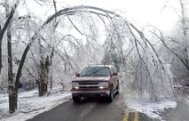 More than a million homes and businesses left in the cold without power Thursday in the wake of an icy winter storm could face a lengthy wait for electricity to come back, even as federal help was promised to two states hit hardest by the blast.
More than a million homes and businesses left in the cold without power Thursday in the wake of an icy winter storm could face a lengthy wait for electricity to come back, even as federal help was promised to two states hit hardest by the blast.
Late Wednesday, President Barack Obama signed requests from Kentucky Gov. Steve Beshear and Arkansas Gov. Mike Beebe for federal emergency declarations. Crews — even the National Guard in Kentucky — worked around the clock to resurrect power lines downed by thick ice in both states. Officials in states from Oklahoma to West Virginia fought to do the same.
Utility officials estimated more than 1.3 million homes and businesses across a wide swath of states were powerless early Thursday, and warned it could be mid-February before some customers had power.
The storm has been blamed for at least 23 deaths so far. Kentucky officials Thursday added two that they called weather-related: A woman who died while an ambulance on the way to her was blocked by impassable roads and a woman who fell on her basement stairs while she was retrieving a kerosene heater.
But officials said a third Kentucky death initially reported as storm related was not. Montgomery County Coroner Wallace Johnson said a man who used home oxygen died after his power went out, but that it was not related to the outage.
Many flocked to shelters, while others huddled next to wood-burning fires and portable heaters to fend off the frigid night air. Some who stayed put relied on gas stoves to cook food. Meanwhile, emergency officials feared the crisis could escalate as temperatures plunged.
“I’m so worried that we’re going to have a death due to hypothermia or carbon monoxide,” said John Robinson, the severe weather coordinator for the National Weather Service at North Little Rock, Ark. Space heaters, if improperly used, can generate dangerous levels of carbon monoxide.
Other communities urged people to conserve water because the outages could limit supplies.
Tony Cipolla managed to keep warm by building a fire at his powerless home near Seneca Park in Louisville, cooking a pot of soup over a gas stove. But there wasn’t a long-term plan for Cipolla and his two children, ages 5 and 9, if electricity wasn’t soon restored.
“If it’ll be a couple days, then we’ll be in trouble,” Cipolla told The Courier-Journal in Louisville, where temperatures dipped into the 20s overnight.
More than a half-million were without power in Kentucky, where the power outages produced by the ice storm were outdone only by the remnants of Hurricane Ike, which lashed the state with fierce winds last year, leaving about 600,000 customers without power.
“We’ve got lots of counties that do not have any communication, any heat, any power,” Beshear, the state’s governor, said Wednesday.
Tree limbs and power lines crackled like gunfire as they snapped, crashing onto now-impassable roads that hampered recovery efforts from the Southern Plains to the East Coast.
Kyle Brashears’ family rode out the storm in their Mountain Home, Ark., home before fleeing to relatives after half an ice-caked oak tree fell into their home.
“It caved the roof in and ripped the gutter off, although it didn’t penetrate inside,” he said. “I was walking around outside until about 1 a.m. and it was just a nonstop medley of tree limbs cracking off.”
Crews in Indiana had restored power to thousands of customers by early Thursday morning — but about 89,000 remained in the dark there. Power lines had buckled under three-fourths of an inch of ice. Parts of central Indiana were still digging out from more than a foot of snow.
Various charities opened shelters across the region, but with the power out nearly everywhere — including at some radio stations — it was difficult to spread the word. Some deputies went door to door and offered to drive the elderly to safety.
Since the storm began building Monday, the weather has been blamed for at least six deaths in Texas, four in Arkansas, three in Virginia, six in Missouri, two in Oklahoma, and one each in Indiana and Ohio. Some parts of New England were expected to see well over a foot of snow as the storm kept moving northeast, but because it turned to snow, ice-related power failures weren’t as big of a concern.
That didn’t mean a trouble-free Wednesday for commuters. Delays or cancellations were reported at airports including those serving Columbus, Cincinnati, Philadelphia, New York and Boston. Commuters on highways encountered a slushy mess.
Tracey Ramey of Waynesville, Ohio, a village about 20 miles southeast of Dayton, said her husband left for his job as a plow operator late Monday with an overnight bag and hasn’t been able to return. He did call her Wednesday morning to caution her not to go to her data-entry job.
“He said, ‘There’s 2 inches of ice on the road and there’s no way you’re going to make it to work,'” she said.




